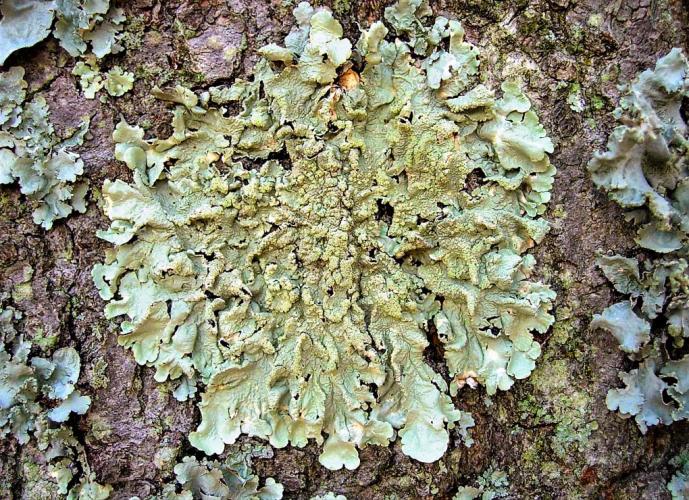Some types of lichens are picky and only like to grow on a particular type of rock, tree, or soil. This explains why certain kinds of rocks or trees can harbor a whole fairy garden of lichens, while others nearby might have few lichens at all.
Lichens often look like an old splotch of paint on a rock or tree. But hiding within that crusty bit of color are two completely different life-forms.
Part Fungus, Part Plant
Fungi belong in a group of living things all by themselves. Plants belong in a completely different group. But when these two separate groups merge, they form a brand-new living thing: a lichen. How does the fungus and the plant benefit from this tangled tango? The fungus provides a good place for the plant to live. For its part, the plant, which has chlorophyll, can make food using air, water, and energy from the sun, and it shares these with the fungus. A pretty good deal!
Can any fungus merge with any plant to make a lichen? Nope, a lichen fungi must meet up with a plant partner in order to grow into the form that we call a lichen.
How Many Kinds of Lichens Does Missouri Have?
The Show-Me State has a little more than 500 species of lichens, and odds are good that some kinds are still waiting to be discovered (by you!). In fact, if you discover a new species, you get to name it. How cool is that?!
What do Lichens Look Like?
Scientists divide lichens into three basic growth forms. Crustose (krustose) lichens look like crusty stains or splotches of old paint. Foliose ( foe-lee-ose) lichens are lobed, frilly, or leafy — like foliage. Careful, though. Lichens don’t have true leaves. However, the lower surface of foliose lichens is a different color than their top surface, so that’s a good clue for identification. Fruticose ( froot-ih-kose) lichens are usually branchy or club-shaped, like fruits. Many lichens have button-shaped parts where the fungi spores form, so they can reproduce.
Crustose
- Gold cobblestone
Foliose
- Powdered ruffle
- Star rosette
Fruticose
- Bushy beard
- British soldier
- Mealy pixie-cup
What Kinds of Lichens Am I Most Likely to See?
Speckled shield and greenshield lichens adorn the trunks of black and red oak trees. Candleflame lichen is common on trees and rocks in neighborhoods and parks. Stalkless cladonia and Dixie reindeer lichens grow on soil along trails in dry woods. Firedot lichen and stippleback leather lichen occur on limestone boulders and outcrops like those you find on glades, a kind of desertlike habitat.
When you go hunting for lichens, carry a magnifying glass, which will help you get a better look at their colors and textures. Also, many kinds of lichens look different when they’re wet. That’s because the fungus part of the lichen becomes transparent and allows the colors of the plant to show through. Try splashing a patch of dry lichens with your water bottle to see it change color and texture.
Where Are the Best Places to See Lichens?
You can find lichens growing pretty much everywhere in Missouri — your playground, local park, or nearest woodsy trail. But you’ll find most of the state’s lichen species growing in all their crusty, frilly, or fruity glory south of the Missouri River.
Winter is a great time to look for lichens because it’s wet and cool enough for them to make food and grow. In the summer, when it’s hot and dry, lichens often become dormant and less colorful. If you’re up for a winter hike, some great places to see lichens are Hughes Mountain Natural Area in Washington County south of Potosi, Lichen Glade Natural Area in St. Clair County, Wildcat Glade in Joplin, and Stegall Mountain Natural Area in Shannon County. Or just visit your nearest conservation nature center, where you’re likely to see lichens on rocks, trees, and branches.
Can I Eat Lichens?
Better not. Many kinds of lichens are poisonous, so it’s best to play it safe ad leave lichens to the wildlife. Take all the photos you want, though!
Who Else Likes Lichens?
If you’re a lichen moth caterpillar or a lichen grasshopper, you like lichens a lot! These critters dependon lichens for food and shelter. Many other animals like deer eat lichens, and some birds like ruby-throated hummingbirds harvest lichens to line their nests. Because lichens, with their soft, absorbent tissues, are extremely sensitive to air pollution, they are also good indicators of air quality. Some scientists even call them sentinels of forest health. To many people, lichens are important because they’re amazing combo creatures, they look cool, and they make exploring nature more fun.












Also In This Issue

This Issue's Staff
Les Fortenberry
Karen Hudson
Angie Daly Morfeld
Noppadol Paothong
Marci Porter
Mark Raithel
Laura Scheuler
Matt Seek
David Stonner
Nichole LeClair Terrill
Stephanie Thurber
Cliff White






















